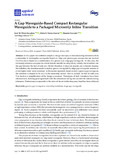Mostrar el registro sencillo del ítem
A gap waveguide-based compact rectangular waveguide to a packaged microstrip inline transition
| dc.creator | Pérez Escudero, José Manuel | es_ES |
| dc.creator | Torres García, Alicia E. | es_ES |
| dc.creator | Gonzalo García, Ramón | es_ES |
| dc.creator | Ederra Urzainqui, Íñigo | es_ES |
| dc.date.accessioned | 2021-01-11T11:43:55Z | |
| dc.date.available | 2021-01-11T11:43:55Z | |
| dc.date.issued | 2020 | |
| dc.identifier.issn | 2076-3417 | |
| dc.identifier.uri | https://hdl.handle.net/2454/38985 | |
| dc.description.abstract | In this paper two different simple to design and easy to manufacturing transitions from a microstrip to rectangular waveguide based on ridge and groove gap waveguides are studied. The first one is based on a combination of a groove and ridge gap waveguide. In this case, the microstrip substrate occupies the whole bottom metallic housing block, namely, the transition and the gap between the bed of nails and the lid; therefore, it does not require any substrate shaping. Nevertheless, the transition needs to replace groove waveguide by ridge gap waveguide sections to avoid higher-order mode excitation. In the second approach, based on only a groove gap waveguide, the substrate is shaped to be only in the microstrip section, that is, outside the bed of nails area. This leads to a simplification of the design procedure. Prototypes of both transitions have been characterized, showing good agreement with the simulations taking into account the manufacturing tolerances. Performance comparable to the state-of-the-art in this frequency band has been achieved. | en |
| dc.description.sponsorship | This research was funded by the Spanish Ministry of Economy and Competitiveness, project numbers TEC2013-47753-C3-1-R, TEC2016-76997-C3-1-R and PID2019-109984RB-C43. | en |
| dc.format.extent | 13 p. | |
| dc.format.mimetype | application/pdf | en |
| dc.language.iso | eng | en |
| dc.publisher | MDPI | en |
| dc.relation.ispartof | Applied Sciences, 2020, 10(14):4979 | en |
| dc.rights | © 2020 by the author. Licensee MDPI, Basel, Switzerland. This article is an open access article distributed under the terms and conditions of the Creative Commons Attribution (CC BY) license. | en |
| dc.rights.uri | http://creativecommons.org/licenses/by/4.0/ | |
| dc.subject | Groove gap waveguide | en |
| dc.subject | Microstrip transition | en |
| dc.subject | Ridge gap waveguide | en |
| dc.title | A gap waveguide-based compact rectangular waveguide to a packaged microstrip inline transition | en |
| dc.type | info:eu-repo/semantics/article | en |
| dc.type | Artículo / Artikulua | es |
| dc.contributor.department | Institute of Smart Cities - ISC | es_ES |
| dc.rights.accessRights | info:eu-repo/semantics/openAccess | en |
| dc.rights.accessRights | Acceso abierto / Sarbide irekia | es |
| dc.identifier.doi | 10.3390/app10144979 | |
| dc.relation.projectID | info:eu-repo/grantAgreement/MINECO//TEC2013-47753-C3-1-R/ES/ | en |
| dc.relation.projectID | info:eu-repo/grantAgreement/ES/1PE/TEC2016-76997 | en |
| dc.relation.publisherversion | https://doi.org/10.3390/app10144979 | |
| dc.type.version | info:eu-repo/semantics/publishedVersion | en |
| dc.type.version | Versión publicada / Argitaratu den bertsioa | es |



